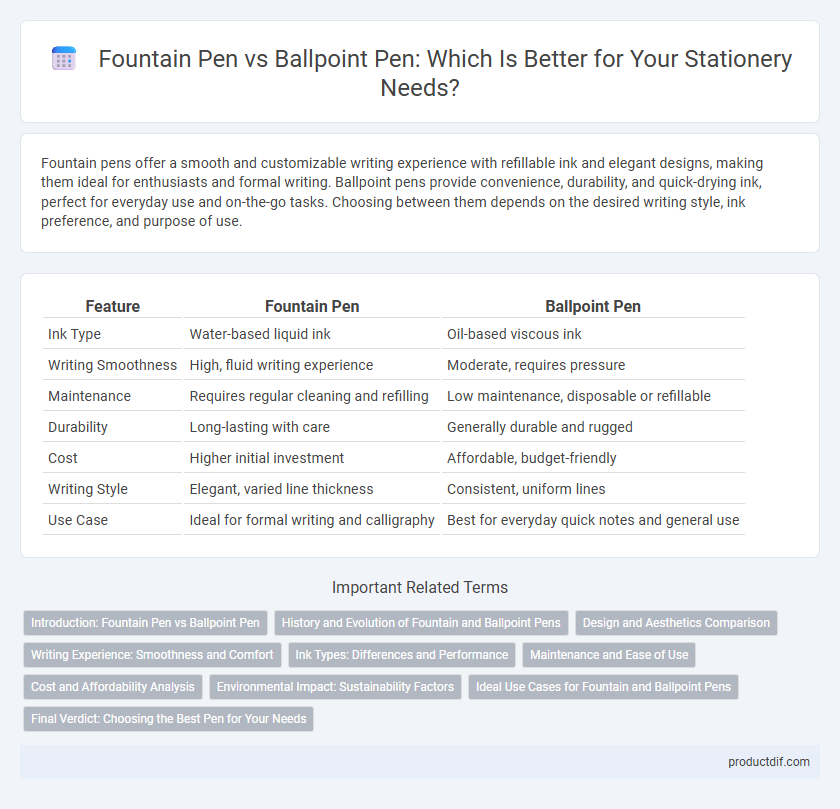Fountain pens offer a smooth and customizable writing experience with refillable ink and elegant designs, making them ideal for enthusiasts and formal writing. Ballpoint pens provide convenience, durability, and quick-drying ink, perfect for everyday use and on-the-go tasks. Choosing between them depends on the desired writing style, ink preference, and purpose of use.
Table of Comparison
| Feature | Fountain Pen | Ballpoint Pen |
|---|---|---|
| Ink Type | Water-based liquid ink | Oil-based viscous ink |
| Writing Smoothness | High, fluid writing experience | Moderate, requires pressure |
| Maintenance | Requires regular cleaning and refilling | Low maintenance, disposable or refillable |
| Durability | Long-lasting with care | Generally durable and rugged |
| Cost | Higher initial investment | Affordable, budget-friendly |
| Writing Style | Elegant, varied line thickness | Consistent, uniform lines |
| Use Case | Ideal for formal writing and calligraphy | Best for everyday quick notes and general use |
Introduction: Fountain Pen vs Ballpoint Pen
Fountain pens use liquid ink delivered through a nib, offering smooth and consistent writing, while ballpoint pens utilize a viscous oil-based ink dispensed by a rotating ball, providing quick drying and low maintenance. Fountain pens excel in creating expressive, elegant handwriting, favored for calligraphy and professional use, whereas ballpoint pens are known for reliability, affordability, and convenience. Choosing between fountain pen and ballpoint pen depends on preferences for writing experience, ink type, and usage frequency.
History and Evolution of Fountain and Ballpoint Pens
Fountain pens, originating in the early 19th century, evolved from dip pens with a built-in reservoir, allowing continuous ink flow and revolutionizing writing convenience. The ballpoint pen, patented by Laszlo Biro in 1938, introduced a tiny rotating ball mechanism that distributes quick-drying ink, drastically reducing smudging and maintenance compared to fountain pens. Over decades, both writing instruments have undergone material and design innovations, reflecting advancements in ergonomics, ink technology, and user preferences in stationery.
Design and Aesthetics Comparison
Fountain pens feature sleek, classic designs with intricate nibs and often luxurious materials like lacquered brass or resin, appealing to collectors and enthusiasts valuing elegance. Ballpoint pens prioritize functional and minimalist aesthetics, focusing on ergonomics and durability with materials such as plastic or metal bodies, catering to everyday practical use. The design of fountain pens typically reflects tradition and craftsmanship, whereas ballpoints emphasize modernity and convenience in form.
Writing Experience: Smoothness and Comfort
Fountain pens offer a smoother writing experience due to their liquid ink flow and flexible nib, reducing hand fatigue during extended use. Ballpoint pens use thicker, oil-based ink that requires more pressure, which can cause discomfort over long writing sessions. The ergonomic design and glide of a fountain pen enhance comfort, making it preferred by enthusiasts seeking elegance and ease.
Ink Types: Differences and Performance
Fountain pens use water-based liquid ink that offers smooth, consistent flow and vibrant color intensity, ideal for detailed writing and calligraphy. Ballpoint pens utilize oil-based, viscous ink that dries quickly and resists smudging, making them more practical for everyday use and rapid note-taking. The unique ink formulations directly impact writing performance, with fountain pen ink requiring careful handling and maintenance, while ballpoint ink ensures durability and minimal bleed-through on most paper types.
Maintenance and Ease of Use
Fountain pens require regular cleaning to prevent ink buildup and ensure smooth ink flow, making maintenance more involved compared to ballpoint pens. Ballpoint pens are low-maintenance, relying on thick, oil-based ink that dries quickly and minimizes smudging, offering convenience for everyday use. Ease of use favors ballpoint pens due to their no-fuss operation and reliability, while fountain pens may need practice to control ink flow and pressure for a consistent writing experience.
Cost and Affordability Analysis
Fountain pens generally have a higher upfront cost compared to ballpoint pens, often ranging from $20 to several hundred dollars for premium models, while ballpoint pens are widely available for under $5. The affordability of ballpoint pens makes them ideal for everyday use and bulk purchasing, whereas fountain pens require ongoing expenses for ink refills and maintenance. Considering long-term costs, ballpoint pens remain more economical for frequent use, whereas fountain pens are favored by enthusiasts prioritizing writing experience over price.
Environmental Impact: Sustainability Factors
Fountain pens significantly reduce environmental impact by relying on refillable ink reservoirs, minimizing plastic waste compared to disposable ballpoint pens. Ballpoint pens often contribute to landfill pollution due to their single-use design and non-refillable ink cartridges. Choosing fountain pens supports sustainability through durable construction and less frequent replacement, promoting eco-friendly writing habits.
Ideal Use Cases for Fountain and Ballpoint Pens
Fountain pens excel in formal settings, calligraphy, and long writing sessions due to their smooth ink flow and customizable nibs, which reduce hand fatigue and enhance handwriting elegance. Ballpoint pens are ideal for everyday use, quick note-taking, and writing on various surfaces, offering durability and low maintenance with their oil-based ink that dries quickly. Selecting between fountain and ballpoint pens depends on the balance of writing comfort, ink type, and the specific context such as professional documents or casual jotting.
Final Verdict: Choosing the Best Pen for Your Needs
Choosing between a fountain pen and a ballpoint pen depends on writing style, maintenance preference, and ink flow requirements. Fountain pens offer smooth, customizable ink flow ideal for long writing sessions and artistic expression, while ballpoint pens provide durability, quick-drying ink, and low maintenance suitable for everyday use. Selecting the best pen involves balancing comfort, ink quality, and intended purpose to achieve optimal writing performance.
Fountain pen vs Ballpoint pen Infographic

 productdif.com
productdif.com